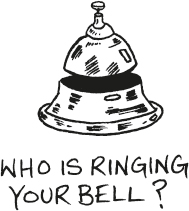Step
30
Don’t stop being an unthinking dog
Don’t scientists make you laugh? Take Ivan Pavlov. I mean, how do you wake up one morning and think, “I know what I’ll do today, I’ll get some dogs (he just so happened to have some about the place) and see if I can build a stimulus and response mechanism in their neurology outside of their conscious awareness”? Pavlov got a hungry dog and gave it some meat, and at the exact moment he gave it the meat, he rang a bell. He only had to do this on average five times to establish a stimulus and response mechanism. To test this, he didn’t offer the dog any meat but just rang the bell and the dog still watered at the mouth. What he discovered is that dogs have ears (thanks to Eddie Izzard for that gag). No, seriously, he proved the bell now had a new meaning or association for the dog.
“Steve, what’s this got to do with anything?” I hear you ask. Well, we are dogs too. If you are in a long-term relationship, you’ll have a mass of associations, most of which are negative, all of which will have been built up, over time, outside of your conscious awareness. Take music. If you are married, there is probably one piece of music you strongly associate with your wedding (remember you and your beloved having the first dance to, let’s say, ‘You are the wind beneath my wings’ – aaaah!). Now, years later, you are driving along when suddenly ‘your song’1 comes on the radio. Instantly, without even thinking about it, you will feel a certain way, especially if you are now divorced. Smell is another powerful anchor to which many of us have a conditioned response. I remember being in a restaurant with my wife Candy. She smelt some really fresh olive oil and was instantly transported back to the kibbutz in Israel where she’d spent six months working (I’m still waiting for her to come home).

Those wacky people in advertising know all about building conditioned responses in us gullible consumers. For instance, complete the following: “A Mars a day helps you work, rest and . . .” or “Mild green Fairy . . .”. The answers are of course ‘play’ and ‘Liquid’ (by the way, for our American friends, Fairy Liquid is only for doing the washing up).
The point is, a peak performer deliberately uses conditioned responses to put themselves into a resourceful state. Why do tennis players constantly twiddle their racket round and round in their hand just before receiving a serve? Because it puts them in the right state. Still, tennis isn’t a proper game, so who cares?
Dogs have also helped prove the existence of something called learned helplessness. Now, out of all the beliefs you can have, this is without doubt the most destructive and damaging. In fact, the study and understanding of learned helplessness is recognised as one of the most important psychological breakthroughs of the last 100 years. A key experiment that first established this learned behaviour took place in the 1960s and was conducted by Dr Martin Seligman of the University of Pennsylvania. Dr Seligman had noticed that while testing some dogs – by giving them electric shocks – some didn’t respond but just lay down, whimpered and stayed in pain. (Before our animal-loving readers go ballistic, Dr Seligman’s explanation for carrying out these types of experiments was that he believed he could find a cure for depression.)
Seligman devised a clever two-stage experiment to discover why some dogs simply gave up. In stage one, dogs in Group A were given a mild electric shock. The dog could stop the shock by pressing a bar with its nose. It soon learned to do this. Dogs in Group B were also given the same electric shock but had no way of switching it off. Dogs in Group C were given no shocks.
The next day, stage two of the experiment took place. The dogs were placed, one at a time, in what Seligman calls a shuttle box. This is a box with a low barrier down the middle. One side of the box is electrified, the other isn’t. The dogs were put on the side where they would receive a continuous, mild electric shock. To get away from the pain, all the dogs had to do was to jump the low barrier to get to the other side. Here is what happened. Group A dogs (those that could control the shocks) and Group C dogs (those that had been given no shock) almost immediately learned they could jump the barrier to get away from the pain. But the Group B dogs (those that could not control the shock in stage one) didn’t even try to escape. They simply lay down and whimpered.
What Dr Seligman, and many others since, had discovered is that these dogs had lost their motivation to act. Now as I’ve said, we are dogs too. In fact, we are worse. Guess how many times it takes a human to learn to be helpless? In one experiment a group of volunteers were placed in a room with several doors leading from it. All the doors were locked and then a very loud noise was pumped into the room. The volunteers immediately tried to get out of the room, but upon discovering that all the doors were locked, simply sat back down and put up with the appalling din. Unbeknown to them, straight after they had tried the doors, the scientists had very quietly unlocked them. The thing is, not one volunteer got up and tried the doors again. They had learned to be helpless in just one go. Like lots of folk, they had the belief that what they did didn’t matter, so why bother? It’s my observation that many organisations are suffering from learned helplessness. This undermines all their attempts to motivate people or introduce effective change.
If you’ve already learned to be helpless, the worst thing you can do is become aware of it, as this would encourage you to have another try. To ensure you don’t fall into this trap, it’s worth understanding something that evolves from learned helplessness, and that is that your success, or for that matter failure, in life will be largely determined by the way you explain or respond to life’s events. Dr Seligman calls this your explanatory style. Here are two crucial elements to your explanatory style.
Permanence
People who fail and give up easily believe that the causes of the bad events that happen to them are permanent. They can’t see past their current circumstances. Whereas achievers, happy people, when they meet problems rarely see them as permanent. They believe the causes of bad events are temporary. Their motto is: “All things must pass.”
“Achievers, happy people, when they meet problems rarely see them as permanent.”
Pervasive
Helplessness can also result from letting the problem spread. While a problem might be a big one, optimists will not let it affect the rest of their lives. They put a ring fence around the problem and contain it. As Dr Seligman says: “Some people can put their troubles neatly into a box and go about their lives even when one important aspect of it – their job, for example, or their love life – is crumbling. Others let one problem bleed all over everything. They catastrophize. When one thread of their lives breaks, the whole fabric unravels. It comes down to this: People who make universal explanations for their failures give up on everything when a failure strikes in one area. People who make specific explanations may become helpless in that one part of their lives, yet march stalwartly on in the others.”
1 I only have to hear another Northern Soul classic (see Answers at the back of this guide), ‘It Really Hurts Me Girl’ by The Carstairs, one of my other all-time favourite records, and I’m catapulted through time on to the dance floor of The Highland Room, Blackpool Mecca, circa 1973.
